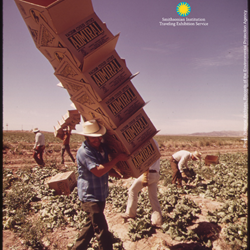
Work and the workplace have gone through enormous changes between the mid-19th century, when 60 percent of Americans made their living as farmers, and the early 21st century. The Smithsonian traveling exhibition, “The Way We Worked,” celebrates the history of work in America. It tells the stories of how hard-working Americans of every ethnicity, class, gender and age power the nation. The exhibition will be on view at the Central Library in Downtown Sacramento from April 29 through July 22.
Sacramento Public Library will also host five in-person programs with local scholars, each addressing an aspect of the panorama of American work.
Why the New Deal Matters
April 29 at 1 p.m. | Library Galleria West Meeting Room
Distinguished Professor of History at UC Davis Dr. Eric Rauchway presents “Why the New Deal Matters,” a look at the legendary labor and public works projects that put New Deal legislation into action.
Organized Labor in Pre-WWII Sacramento
May 6 at 1 p.m. | Library Galleria West Meeting Room
William Burg, historian and President of Preservation Sacramento, presents a deep-dive into the Industrial Workers of the World in Sacramento. Burg will also explore the 1894 Pullman strike, Kelley's Army in 1913, the bombing of the Governor's Mansion and the "Silent Defenders" in 1918-1919, and how official reaction to those events led to the "Criminal Syndicalism" laws that ended up with prosecution of Cannery and Agricultural Workers Industrial Union cannery workers in the 1930s.
Sacramento and the 2nd Great Migration
May 27 at 1 p.m. | Library Galleria West Meeting Room
Dr. Damany Fisher, principal historian for the Sacramento African American Experience Project’s context statement, presents the impacts of the Second Great Migration on Sacramento labor, housing, and culture.
The Summit Tunnel: Diversity and Pride in Building the American Nation
June 10 at 1 p.m. | Sacramento Room
Phil Sexton, natural and cultural history interpreter with the 1882 Foundation and Summit Tunnel Conservation Association, presents “The Summit Tunnel: Diversity and Pride in Building the American Nation,” a short video with an even shorter slide presentation about the history and legacy of the thousands of unknown Chinese laborers who built the western portion of the Pacific Railroad that continues to influence our lives today.
The Plight of the Cannery Workers Committee in Northern California
July 22 at 1 p.m. | Library Galleria West Meeting Room
Dr. Lorena Marquez, associate professor of Chicana/o studies at UC Davis presents the compelling story of how, in 1969, ethnic Mexican cannery workers at Libby, McNeil, and Libby came together to demand race and gender equality in one of the most labor exploitative industries in California by forming the CWC.
 The Way We Worked,
The Way We Worked, an exhibition created by the National Archives, is adapted for travel by the Smithsonian Institution Traveling Exhibition Service (SITES) and made possible with the generous support of the United States Congress.
“The work that each of us does every day speaks volumes about who we are as individuals, as communities and as a country,” said Myriam Springuel, director of SITES and Smithsonian Affiliations. “We all have our own work journeys, and each one of these jobs reflects the various kinds of work that has and continues to build and strengthen the nation.”
“The Way We Worked” brings to light the who, what, where, why and how of Americans at work. It explores the places Americans worked, from farms to factories and mines to restaurants, as well as in homes. It examines not only the effects of technology and automation, but also how workers striving for better working conditions, wages and hours, and an end to racial and gender discrimination, changed America’s work history. The exhibition illustrates how America’s workforce is as diverse as the nation itself. Dreams of new jobs and opportunities led millions to America’s shores. “The Way We Worked” provides some answers to why people work—from simply paying the bills to pursuing a calling, serving the country and giving back to the community. It explores what work tells people about each other. Whole communities may become known by the work that happens there, like Idaho’s Silver Valley with its strong mining heritage.
“The Way We Worked” is accompanied by an audio tour that allows visitors to access additional details provided by exhibition curator, Bruce Bustard, former senior curator for the National Archives.
The photos featured in the exhibition come from the vast collection of the National Archives, which is home to thousands of photos of work and workplaces taken by government agencies. The images featured in “The Way We Worked,” though possibly taken merely for purposes of record keeping, often reveal much more about how social forces such as immigration, gender, ethnicity, class and technology transformed the workforce.
SITES has been sharing the wealth of Smithsonian collections and research programs with millions of people outside Washington, D.C., for more than 65 years. SITES connects Americans to their shared cultural heritage through a wide range of exhibitions about art, science and history, which are shown wherever people live, work and play. For exhibition description and tour schedules, visit
www.sites.si.edu.